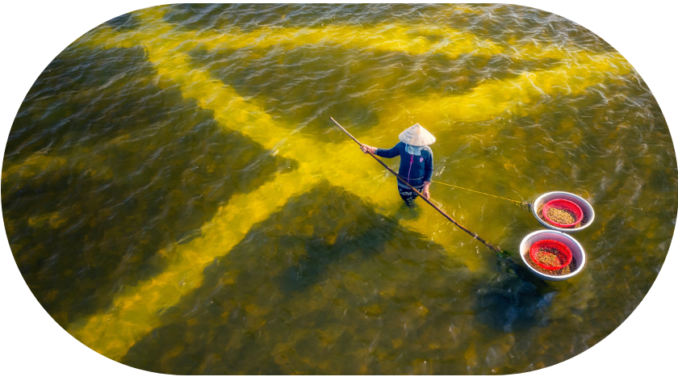
QUANG NGAI – Tra Khuc River with mud and sand streaks stretching through the process like an art picture when viewed from above.

Early in the morning, more than 10 boats gather to rake don at the end of Tra Khuc river. People in Co Luy village – Vinh Tho Bac, Nghia Phu commune, Tu Nghia district have considered this a traditional profession to make a living for many generations.
The photo set “Scratch donation” was made by photographer Nguyen Tan Tuan, a Quang Ngai resident currently living in Ho Chi Minh City. Talking about his hometown, he said that outside Thien An mountain, it is impossible not to mention the Tra Khuc River, about 140 km long. The river brings to the people many delicious products such as don, goby, and snakehead fish …

Mr. Tuan shared, people who scratch don have to soak in water for 4-6 hours. Many people are stepping on bottles while practicing and sometimes have leg cramps.
In Nghia Phu commune, there are nearly 100 households living by this profession. They “eat the river and sleep in the water” with don, bring rice and go to the field when dawn comes. On average, a person rake about 20 kg of donation per day, sell it to traders and the rest bring to the family to cook dishes.

Co Luy people rake don mainly from February to September, but the demand for buyers is increasing so they exploit until the Lunar New Year to sell.

The donor rake weighs more than 10 kg, consists of a bamboo handle 2.5 m long and a rake box one meter long. The rake is attached to the strap at the hip level, the person holding the bamboo handle with one hand and the other with the waist resting in a recoil.
In recent years, people worry about getting less and less. They hope for a clean river and water environment to continue to reproduce, to keep the long-standing delicacy in Quang.

Don is a mollusk, the shell has two flattened pieces and is only about 1 cm long, the inside of the flesh is milky white and fringed around. They are from the same mussel family but have long intestines and taste better meat. Don is yellow by living and deep in the sand layer.
To process don, have to scrub, wash, soak to release all the sand, then boil until they open their mouth. Keep the broth and the baby separate, stirring the broth with the chopsticks so that the meat falls off the shell. Don can make many delicious dishes such as soup, porridge, and dry fried.

The Tra Khuc river supports many generations of people making a living by the river, especially the rake. This job, if anyone learns fast, it is from 5 days to a week, the slow one sometimes up to 2 months.

The streaks of mud and sand stretching downstream of the river due to scratching are in harmony with the blue water color like a picture of life when viewed from above.

Villagers donated near Co Luy bridge while finishing the final items. The bridge has now been completed, opened to traffic on October 20, 2020, with a length of nearly 1,880 m, designed with pre-stressed reinforced concrete.
Follow vnexpress
